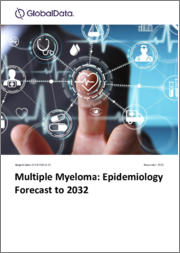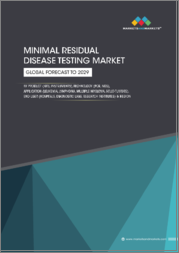
|
시장보고서
상품코드
1388256
다발성 골수종 역학 분석 및 예측(-2032년)Multiple Myeloma Epidemiology Analysis and Forecast to 2032 |
||||||
다발성 골수종(MM)은 형질세포라고 하는 백혈구의 일종에서 발생하는 혈액암입니다. 정상적인 형질세포는 박테리아를 인식하고 공격하는 항체를 생성하여 감염과 싸우는 데 도움이 되지만, MM은 암세포가 골수에 축적되어 건강한 혈액 세포를 차단하여 감염과 싸우는 능력을 손상시킵니다. 암세포는 유용한 항체를 생산하지 않고 단클론성 면역글로불린, 단클론성 단백질(M 단백질), M 스파이크 또는 파라단백질이라고 불리는 비정상적인 단백질을 생산합니다. 초기에는 아무런 증상을 일으키지 않을 수 있습니다. 결국에는 등, 갈비뼈, 허리 등의 지속적인 뼈 통증, 피로, 쇠약, 호흡곤란, 체중 감소, 반복적인 감염, 타박상 및 비정상적인 출혈, 연약한 뼈, 갈증 등 다양한 문제를 일으킵니다.
주요 8개국 시장에서 MM 진단 건수는 2022년 80,305건에서 2032년 95,349건으로 연평균 증가율(AGR) 1.87%로 증가할 것으로 예상됩니다. 2032년 주요 8개국 시장에서 MM 진단 건수가 가장 많은 국가는 미국으로 35,307건이 진단될 것으로 예상되며, 스페인은 3,517건으로 가장 적은 발병 건수를 기록할 것으로 예상됩니다. 주요 8개국 시장에서 MM으로 진단된 발병 사례는 2022년 272,948건에서 2032년 305,020건으로 증가해 1.18%의 AGR을 기록할 것으로 예상했습니다.
이 보고서는 주요 8개국 시장의 다발성 골수종(MM) 위험인자, 동반질환, 세계 및 과거 역학 동향을 살펴보고, 다발성 골수종(MM) 진단 사례와 진단 유병률에 대한 10년 역학 예측을 정리했습니다.
목차
제1장 다발성 골수종(MM) : 주요 요약
제2장 역학
- 질병 배경
- 위험인자와 병존질환
- 세계적 및 역사적 동향
- 주요 8개국 시장 예측 조사 방법
- 다발성 골수종(MM) 역학 예측(2022-2032년)
- 다발성 골수종(MM) 진단된 증례 건수
- 다발성 골수종(MM) 진단된 발증례, 연령별
- 다발성 골수종(MM) 진단된 발증례, 성별
- 다발성 골수종(MM) 진단된 발증례, 유형별
- 다발성 골수종(MM) 진단된 발증례, 진단시 병기별
- 다발성 골수종(MM) 진단된 발증례, SCT 적격성별
- 다발성 골수종(MM) 진단된 발증례, 유전자·표면 마커별
- 다발성 골수종(MM) 진단된 이환 건수
- 다발성 골수종(MM) 진단된 이환 증례, 성별
- 다발성 골수종(MM) 진단된 이환 증례, 진단시 병기별
- 다발성 골수종(MM) 이환 증례, 유전자·표면 마커별
- 논의
- 역학 예측 인사이트
- COVID-19의 영향
- 분석의 한계
- 분석의 강점
제3장 부록
ksm 23.12.06Abstract
Multiple myeloma (MM) (International Statistical Classification of Diseases and Related Health Problems, 10th Revision [ICD-10] code = C90.0 or ICD-O-3 code: 9732/3) is a hematologic cancer that forms in a type of white blood cells called plasma cells. Normal plasma cells help fight infections by making antibodies that recognize and attack germs, but MM causes cancer cells to accumulate in the bone marrow where they crowd out healthy blood cells, impairing their ability to fight infections. Rather than producing helpful antibodies, the cancer cells produce abnormal proteins called monoclonal immunoglobulin or monoclonal protein (M-protein) or M-spike or paraprotein (American Cancer Society, 2018; Mayo Clinic, 2023). In the early stages, MM may not cause any symptoms. Eventually, MM causes a wide range of problems, including a persistent bone pain, usually in the back, ribs, or hips, tiredness, weakness, shortness of breath, weight loss, repeated infections, easy bruising and unusual bleeding, fragile bones, thirst, frequent urination, and kidney problems (American Cancer Society, 2018; National Health Service, 2021; Mayo Clinic, 2023).
In the 8MM, the diagnosed incident cases of MM are expected to increase from 80,305 cases in 2022 to 95,349 cases in 2032, at an Annual Growth Rate (AGR) of 1.87%. In 2032, the US will have the highest number of diagnosed incident cases of MM in the 8MM, with 35,307 diagnosed incident cases, whereas Spain will have the fewest diagnosed incident cases with 3,517 cases. In the 8MM, the diagnosed prevalent cases of MM are expected to increase from 272,948 cases in 2022 to 305,020 cases in 2032, at an AGR of 1.18%. GlobalData epidemiologists attribute the increase in the diagnosed incident cases and diagnosed prevalent cases of MM to a certain extent with the moderately rising trend in the incidence of MM in the 8MM, combined with underlying demographic changes in the respective markets.
Scope
- This report provides an overview of the risk factors, comorbidities, and the global and historical epidemiological trends for MM in the eight major markets (8MM: US, France, Germany, Italy, Spain, UK, Japan, and Urban China).
- The report includes a 10-year epidemiology forecast for the diagnosed incident and diagnosed prevalent cases of MM. The diagnosed incident cases of MM are segmented by age (18 years and older), sex, by type (asymptomatic and symptomatic), by stage at diagnosis (R-ISS stage I, R-ISS stage II, and R-ISS stage III), by stem cell transplant (SCT) eligibility (eligible and ineligible), and by genetic and surface markers [t(4;14)(p16;q32), t(14;16)(q32;q23), t(14;20) (q32;q12), t(11;14)(q13;q32), and deletion 17p].
- The diagnosed prevalent cases of MM are segmented sex, by stage at diagnosis (R-ISS stage I, R-ISS stage II, and R-ISS stage III), and by genetic and surface markers [t(4;14)(p16;q32), t(14;16)(q32;q23), t(14;20) (q32;q12), t(11;14)(q13;q32), and deletion 17p].
- This epidemiology forecast for MM is supported by data obtained from peer-reviewed articles and population-based studies.
- The forecast methodology was kept consistent across the 8MM to allow for a meaningful comparison of the forecast diagnosed incident and diagnosed prevalent cases of MM across these markets.
Reasons to Buy
The Multiple Myeloma epidemiology series will allow you to -
- Develop business strategies by understanding the trends shaping and driving the global MM market.
- Quantify patient populations in the global MM market to improve product design, pricing, and launch plans.
- Organize sales and marketing efforts by identifying the age groups that present the best opportunities for MM therapeutics in each of the markets covered.
Table of Contents
Table of Contents
1 Multiple Myeloma: Executive Summary
- 1.1 Catalyst
- 1.2 Related Reports
- 1.3 Upcoming Reports
2 Epidemiology
- 2.1 Disease background
- 2.2 Risk factors and comorbidities
- 2.3 Global and historical trends
- 2.4 8MM forecast methodology.
- 2.4.1 Sources
- 2.4.2 Forecast assumptions and methods.
- 2.4.3 Forecast assumptions and methods: diagnosed incident cases of MM.
- 2.4.4 Forecast assumptions and methods: diagnosed incident cases of MM by type.
- 2.4.5 Forecast assumptions and methods: diagnosed incident cases of MM by stage at diagnosis (R-ISS stage)
- 2.4.6 Forecast assumptions and methods: diagnosed incident cases of MM by SCT eligibility.
- 2.4.7 Forecast assumptions and methods: diagnosed incident cases of MM by genetic and surface markers.
- 2.4.8 Forecast assumptions and methods: diagnosed prevalent cases of MM
- 2.4.9 Forecast assumptions and methods: diagnosed prevalent cases of MM by stage at diagnosis (R-ISS stage)
- 2.4.10 Forecast assumptions and methods: diagnosed prevalent cases of MM by genetic and surface markers.
- 2.5 Epidemiological forecast for multiple myeloma (2022-32)
- 2.5.1 Diagnosed incident cases of MM.
- 2.5.2 Age-specific diagnosed incident cases of MM
- 2.5.3 Sex-specific diagnosed incident cases of MM
- 2.5.4 Diagnosed incident cases of MM by type.
- 2.5.5 Diagnosed incident cases of MM by stage at diagnosis (R-ISS stage)
- 2.5.6 Diagnosed incident cases of MM by SCT eligibility.
- 2.5.7 Diagnosed incident cases of MM by genetic and surface markers.
- 2.5.8 Diagnosed prevalent cases of MM.
- 2.5.9 Sex-specific diagnosed prevalent cases of MM
- 2.5.10 Diagnosed prevalent cases of MM by stage at diagnosis (R-ISS stage)
- 2.5.11 Diagnosed prevalent cases of MM by genetic and surface markers.
- 2.6 Discussion
- 2.6.1 Epidemiological forecast insight
- 2.6.2 COVID-19 impact.
- 2.6.3 Limitations of the analysis
- 2.6.4 Strengths of the analysis
3 Appendix
- 3.1 Bibliography
- 3.2 About the Authors
- 3.2.1 Epidemiologist
- 3.2.2 Reviewers
- 3.2.3 Vice President of Disease Intelligence and Epidemiology
- Contact Us

















